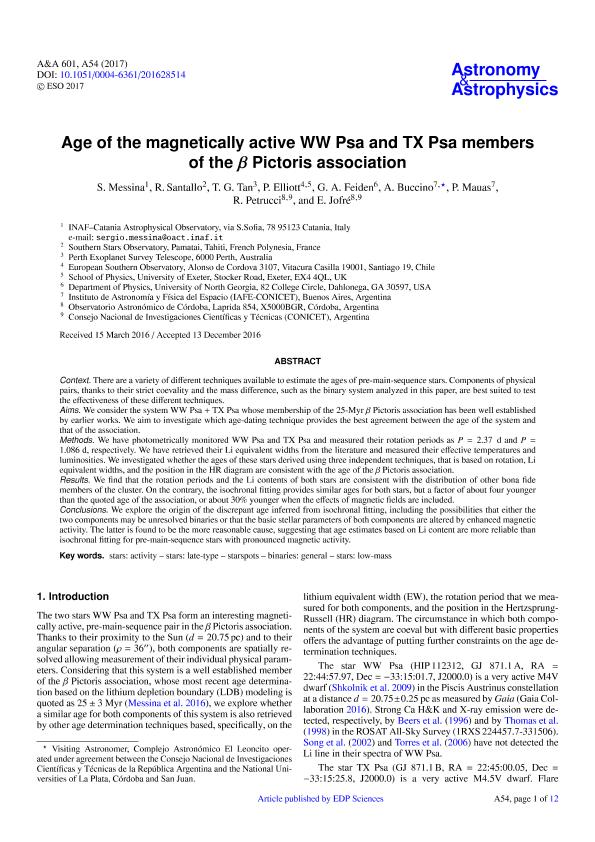Mostrar el registro sencillo del ítem
dc.contributor.author
Messina, S.
dc.contributor.author
Santallo, R.
dc.contributor.author
Tan, T.
dc.contributor.author
Elliot, P.
dc.contributor.author
Feiden, G.
dc.contributor.author
Buccino, Andrea Paola

dc.contributor.author
Mauas, Pablo Jacobo David

dc.contributor.author
Petrucci, Romina Paola

dc.contributor.author
Jofré, E.
dc.date.available
2022-12-03T02:25:37Z
dc.date.issued
2016-12
dc.identifier.citation
Messina, S.; Santallo, R.; Tan, T.; Elliot, P.; Feiden, G.; et al.; On the age of the magnetically active WW Psa and TX Psa members of the beta Pictoris association; EDP Sciences; Astronomy and Astrophysics; 601; A54; 12-2016; 1-12
dc.identifier.issn
0004-6361
dc.identifier.uri
http://hdl.handle.net/11336/180085
dc.description.abstract
Context. There are a variety of different techniques available to estimate the ages of pre-main-sequence stars. Components of physical pairs, thanks to their strict coevality and the mass difference, such as the binary system analyzed in this paper, are best suited to test the effectiveness of these different techniques. Aims. We consider the system WW Psa + TX Psa whose membership of the 25-Myr β Pictoris association has been well established by earlier works. We aim to investigate which age-dating technique provides the best agreement between the age of the system and that of the association. Methods. We have photometrically monitored WW Psa and TX Psa and measured their rotation periods as P = 2.37 d and P = 1.086 d, respectively. We have retrieved their Li equivalent widths from the literature and measured their effective temperatures and luminosities. We investigated whether the ages of these stars derived using three independent techniques, that is based on rotation, Li equivalent widths, and the position in the HR diagram are consistent with the age of the β Pictoris association. Results. We find that the rotation periods and the Li contents of both stars are consistent with the distribution of other bona fide members of the cluster. On the contrary, the isochronal fitting provides similar ages for both stars, but a factor of about four younger than the quoted age of the association, or about 30% younger when the effects of magnetic fields are included. Conclusions. We explore the origin of the discrepant age inferred from isochronal fitting, including the possibilities that either the two components may be unresolved binaries or that the basic stellar parameters of both components are altered by enhanced magnetic activity. The latter is found to be the more reasonable cause, suggesting that age estimates based on Li content are more reliable than isochronal fitting for pre-main-sequence stars with pronounced magnetic activity.
dc.format
application/pdf
dc.language.iso
eng
dc.publisher
EDP Sciences

dc.rights
info:eu-repo/semantics/openAccess
dc.rights.uri
https://creativecommons.org/licenses/by-nc-sa/2.5/ar/
dc.subject
BINARIES: GENERAL
dc.subject
STARS: ACTIVITY
dc.subject
STARS: LATE-TYPE
dc.subject
STARS: LOW-MASS
dc.subject
STARSPOTS
dc.subject.classification
Otras Ciencias Naturales y Exactas

dc.subject.classification
Otras Ciencias Naturales y Exactas

dc.subject.classification
CIENCIAS NATURALES Y EXACTAS

dc.title
On the age of the magnetically active WW Psa and TX Psa members of the beta Pictoris association
dc.type
info:eu-repo/semantics/article
dc.type
info:ar-repo/semantics/artículo
dc.type
info:eu-repo/semantics/publishedVersion
dc.date.updated
2022-12-01T14:17:21Z
dc.journal.volume
601
dc.journal.number
A54
dc.journal.pagination
1-12
dc.journal.pais
Francia

dc.journal.ciudad
Paris
dc.description.fil
Fil: Messina, S.. Osservatorio Astrofisico Di Catania; Italia
dc.description.fil
Fil: Santallo, R.. Southern Stars Observatory; Polinesia Francesa
dc.description.fil
Fil: Tan, T.. Perth Exoplanet Survey Telescope; Australia
dc.description.fil
Fil: Elliot, P.. European Southern Observatory; Chile
dc.description.fil
Fil: Feiden, G.. Uppsala Universitet; Suecia
dc.description.fil
Fil: Buccino, Andrea Paola. Consejo Nacional de Investigaciones Científicas y Técnicas. Oficina de Coordinación Administrativa Ciudad Universitaria. Instituto de Astronomía y Física del Espacio. - Universidad de Buenos Aires. Facultad de Ciencias Exactas y Naturales. Instituto de Astronomía y Física del Espacio; Argentina
dc.description.fil
Fil: Mauas, Pablo Jacobo David. Consejo Nacional de Investigaciones Científicas y Técnicas. Oficina de Coordinación Administrativa Ciudad Universitaria. Instituto de Astronomía y Física del Espacio. - Universidad de Buenos Aires. Facultad de Ciencias Exactas y Naturales. Instituto de Astronomía y Física del Espacio; Argentina
dc.description.fil
Fil: Petrucci, Romina Paola. Universidad Nacional de Córdoba. Observatorio Astronómico de Córdoba; Argentina. Consejo Nacional de Investigaciones Científicas y Técnicas. Centro Científico Tecnológico Conicet - Córdoba; Argentina
dc.description.fil
Fil: Jofré, E.. Universidad Nacional de Córdoba. Observatorio Astronómico de Córdoba; Argentina
dc.journal.title
Astronomy and Astrophysics

dc.relation.alternativeid
info:eu-repo/semantics/altIdentifier/url/https://www.aanda.org/articles/aa/pdf/2017/05/aa28514-16.pdf
dc.relation.alternativeid
info:eu-repo/semantics/altIdentifier/doi/https://doi.org/10.1051/0004-6361/201628514
Archivos asociados
